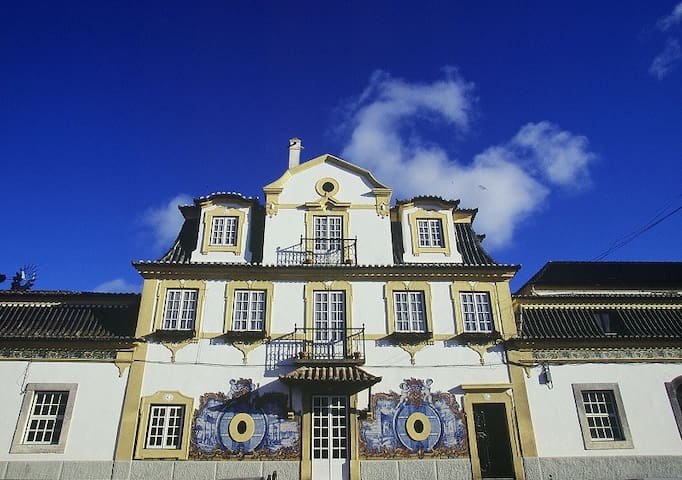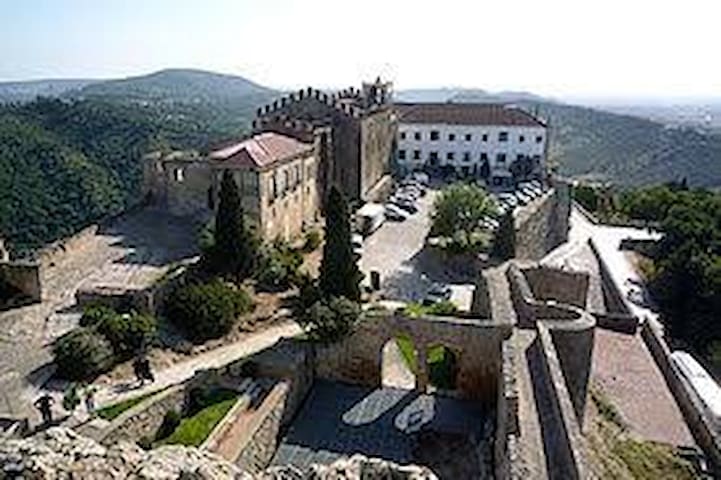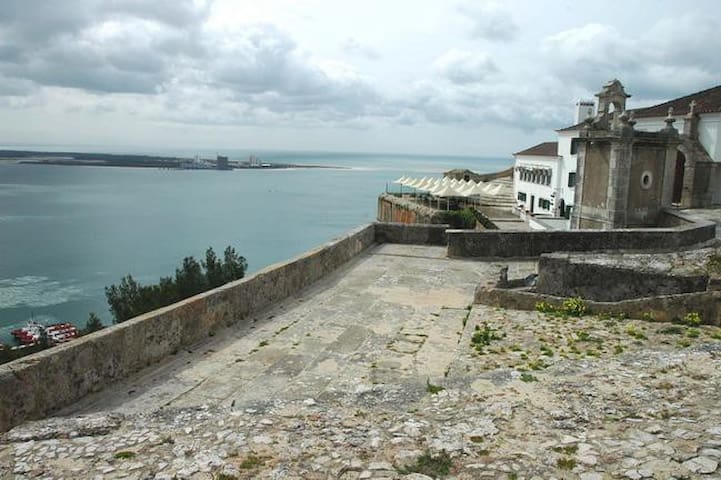Wines and spirits
For wine and spirits enthusiasts, these are the places you must visit in the region.
Built in 1834, the house was restored in 1923 by the Swiss architect, Ernesto Korrodi, and was the Soares Franco family residence until 1974. With its particularly beautiful façade and gardens, it has always been associated with the image of José Maria da Fonseca.
The visit to the Museum House begins with a brief explanation of the company’s history, followed by a tour of the ancient wine cellars: Adega da Mata and Adega dos Teares Novos, where wines such as Periquita mature, and Adega dos Teares Velhos, where the oldest Setúbal Muscatels (Muscats or Moscateis) rest, some of which are true relics over 100 years old. At the end of the tour, the visitor can sample some of the wines produced by José Maria da Fonseca.
When you visit our Wine Shop, you’ll be spoilt for choice for that special occasion and you can complement the wine with regional gourmet products.
VISITS
Monday to Sunday (Including Bank Holidays)
Close on December 24th (afternoon), 25th, 31st (afternoon) and January 1st.
SUMMER
From April to October
Morning
from 10:00am to 12:00am
Afternoon
from 2:00pm to 5:30pm
WINTER
From November to March
Morning
10:00am to 12:00am
Afternoon
2:30pm to 4:30pm
Recommended pre-booking
WINE SHOP
SUMMER
April to October
From 10:00am to 7:00pm
SUMMER
From November to March
From 10:00am to 5:30pm
89 lokal ang nagrerekomenda
Jose Maria de Fonseca
12a R. José Augusto CoelhoBuilt in 1834, the house was restored in 1923 by the Swiss architect, Ernesto Korrodi, and was the Soares Franco family residence until 1974. With its particularly beautiful façade and gardens, it has always been associated with the image of José Maria da Fonseca.
The visit to the Museum House begins with a brief explanation of the company’s history, followed by a tour of the ancient wine cellars: Adega da Mata and Adega dos Teares Novos, where wines such as Periquita mature, and Adega dos Teares Velhos, where the oldest Setúbal Muscatels (Muscats or Moscateis) rest, some of which are true relics over 100 years old. At the end of the tour, the visitor can sample some of the wines produced by José Maria da Fonseca.
When you visit our Wine Shop, you’ll be spoilt for choice for that special occasion and you can complement the wine with regional gourmet products.
VISITS
Monday to Sunday (Including Bank Holidays)
Close on December 24th (afternoon), 25th, 31st (afternoon) and January 1st.
SUMMER
From April to October
Morning
from 10:00am to 12:00am
Afternoon
from 2:00pm to 5:30pm
WINTER
From November to March
Morning
10:00am to 12:00am
Afternoon
2:30pm to 4:30pm
Recommended pre-booking
WINE SHOP
SUMMER
April to October
From 10:00am to 7:00pm
SUMMER
From November to March
From 10:00am to 5:30pm
500 years of history - from the Portuguese Royal family till nowadays. An incredible place to be known!
The Quinta da Bacalhôa estate, formerly belonging to the Portuguese royal family, dates back to the first half of the XV Century, and is considered to be the most beautiful Portuguese estate from this era still in existence today. Situated in Azeitão, the estate and the famous Palácio da Bacalhôa together constitute an artistic monument of the greatest relevance to the country.
In the XIV Century, the property, used then as a country leisure estate, belonged to João, Prince of Portugal who was the son of King João I. It was inherited by his daughter, Lady Brites, who was married to the second Duke of Viseu and who was also mother to King Manuel I. The buildings are still in existence today, as are the walls with domed turrets and the large irrigation tank, all built by order of Lady Brites.
Quinta da Bacalhôa would come to be sold in 1528 to Dom Brás de Albuquerque, eldest son of Dom Afonso de Albuquerque. The new owner not only enriched the buildings with beautiful tiles, but had a harmonious garden house built beside the lake, in addition to two sturdy pavilions along the lateral walls.
Towards the end of the XVI Century, this estate formed part of the inheritance belonging to Dom Jerónimo Teles Barreto, descendant of Afonso de Albuquerque. All of this was eventually inherited by his sister, Lady Maria Mendonça de Albuquerque, who was married to Dom Jerónimo Manuel, nicknamed "Bacalhau" (Codfish).
It is highly likely that "Bacalhôa", by which the old Vila Fresca estate in Azeitão became known, originated from the fact that the wife of Dom Jerónimo Manuel was referred to by this name, the female form of "Codfish". This estate was established as one of the artistic treasures of Portugal.
In 1936, the Bacalhôa Palace was bought and restored by Orlena Scoville, a North American. In the 1970's her grandson set about transforming the property into one of the largest producers of wine in Portugal.
It was classified a National Monument in 23th June of 1910.
OPENING HOURS:
Shop: 10 am to 6:30 pm
Guided Tours: 10am | 15pm (Other schedules on request)
NOTE: Closed on Sundays and National Holidays
IMPORTANT:
Duration of guided tour with wine tasting: 90 minutes, inclueded a wine tasting;
Durantion of guided toue to Palácio da Bacalhôa + Adega/Museu Bacalhôa: 2h30;
PRICE LIST:
- Adega/Museu Bacalhôa - 3€
- Palácio da Bacalhôa - 8€
- Palácio da Bacalhôa + Adega/Museu Bacalhôa - 10€
NOTE: For visitors with no prior booking, tours will take place in accordance with staff availability to conduct them.
55 lokal ang nagrerekomenda
Bacalhôa Mga Alak ng Portugal
500 years of history - from the Portuguese Royal family till nowadays. An incredible place to be known!
The Quinta da Bacalhôa estate, formerly belonging to the Portuguese royal family, dates back to the first half of the XV Century, and is considered to be the most beautiful Portuguese estate from this era still in existence today. Situated in Azeitão, the estate and the famous Palácio da Bacalhôa together constitute an artistic monument of the greatest relevance to the country.
In the XIV Century, the property, used then as a country leisure estate, belonged to João, Prince of Portugal who was the son of King João I. It was inherited by his daughter, Lady Brites, who was married to the second Duke of Viseu and who was also mother to King Manuel I. The buildings are still in existence today, as are the walls with domed turrets and the large irrigation tank, all built by order of Lady Brites.
Quinta da Bacalhôa would come to be sold in 1528 to Dom Brás de Albuquerque, eldest son of Dom Afonso de Albuquerque. The new owner not only enriched the buildings with beautiful tiles, but had a harmonious garden house built beside the lake, in addition to two sturdy pavilions along the lateral walls.
Towards the end of the XVI Century, this estate formed part of the inheritance belonging to Dom Jerónimo Teles Barreto, descendant of Afonso de Albuquerque. All of this was eventually inherited by his sister, Lady Maria Mendonça de Albuquerque, who was married to Dom Jerónimo Manuel, nicknamed "Bacalhau" (Codfish).
It is highly likely that "Bacalhôa", by which the old Vila Fresca estate in Azeitão became known, originated from the fact that the wife of Dom Jerónimo Manuel was referred to by this name, the female form of "Codfish". This estate was established as one of the artistic treasures of Portugal.
In 1936, the Bacalhôa Palace was bought and restored by Orlena Scoville, a North American. In the 1970's her grandson set about transforming the property into one of the largest producers of wine in Portugal.
It was classified a National Monument in 23th June of 1910.
OPENING HOURS:
Shop: 10 am to 6:30 pm
Guided Tours: 10am | 15pm (Other schedules on request)
NOTE: Closed on Sundays and National Holidays
IMPORTANT:
Duration of guided tour with wine tasting: 90 minutes, inclueded a wine tasting;
Durantion of guided toue to Palácio da Bacalhôa + Adega/Museu Bacalhôa: 2h30;
PRICE LIST:
- Adega/Museu Bacalhôa - 3€
- Palácio da Bacalhôa - 8€
- Palácio da Bacalhôa + Adega/Museu Bacalhôa - 10€
NOTE: For visitors with no prior booking, tours will take place in accordance with staff availability to conduct them.
Passeio turístico
O Castelo de Palmela, tem origem árabe, com a primeira fortificação, provavelmente, edificada por volta do século IX, depois da conquista desta região aos visigodos, mas onde os testemunhos arqueológicos, apontam para uma ocupação humana desde o período neolítico. D. Afonso Henriques conquistou Palmela em 1147, mas voltaria a cair na mão dos muçulmanos e só por volta de 1190, passaria definitivamente para a posse portuguesa. D. Sancho I, mandou fazer reparações na fortaleza e doou-a à Ordem de Santiago, que fizeram de Palmela a sede da Ordem. É já no reinado de D. João I que se inicia a construção do convento onde esta ordem se instala, a partir de 1443. D. Pedro II, por volta de 1670, modernizou as suas defesas, adaptando-as ao uso de artilharia, mas as suas estruturas viriam a ser seriamente danificadas com o terramoto de 1755. Este acontecimento e a extinção das ordens religiosas, lançou esta fortaleza no abandono, até à sua classificação como Monumento Nacional e à execução de obras de restauro iniciadas em 1945.
79 lokal ang nagrerekomenda
Kastilyo ng Palmela
Avenida dos Cavaleiros de Santiago e EspadaO Castelo de Palmela, tem origem árabe, com a primeira fortificação, provavelmente, edificada por volta do século IX, depois da conquista desta região aos visigodos, mas onde os testemunhos arqueológicos, apontam para uma ocupação humana desde o período neolítico. D. Afonso Henriques conquistou Palmela em 1147, mas voltaria a cair na mão dos muçulmanos e só por volta de 1190, passaria definitivamente para a posse portuguesa. D. Sancho I, mandou fazer reparações na fortaleza e doou-a à Ordem de Santiago, que fizeram de Palmela a sede da Ordem. É já no reinado de D. João I que se inicia a construção do convento onde esta ordem se instala, a partir de 1443. D. Pedro II, por volta de 1670, modernizou as suas defesas, adaptando-as ao uso de artilharia, mas as suas estruturas viriam a ser seriamente danificadas com o terramoto de 1755. Este acontecimento e a extinção das ordens religiosas, lançou esta fortaleza no abandono, até à sua classificação como Monumento Nacional e à execução de obras de restauro iniciadas em 1945.
Sesimbra Castle
Classified as a National Monument on June 16, 1910, the Castle of Sesimbra is the last of the Castles on the sea, which arrived, well preserved, until our days.
The Castle of Sesimbra is the last of the Portuguese castles on the sea to maintain the medieval moth. It was classified as National Monument on June 16, 1910 and within its walls brings together various reasons of interest. Its walls have a unique view over the village and the sea. Inside there are two permanent exhibits on its history, heritage interpretation center, church, a disabled cemetery. It also offers a museum circuit that allows the visitor, autonomously, to enjoy the various points of interest of the Property. Visitors can walk through the walls and enjoy a privileged view of the village of Sesimbra and the region. The cafeteria with terrace offers some local products. It stands out in the landscape by its imposing.
The origins of the Castle of Sesimbra go back to the IX century, period of the Muslim occupation of the territory. In 1165 is conquered by D. Afonso Henriques, and in 1191 is lost to the Almohads. Its definitive reconquest takes place on the initiative of D. Sancho I, in 1199, monarch who attributes the first charter to the village of Sesimbra, then based inside the monument.
Throughout the Middle Ages, and given its strategic importance in defense of the maritime and land borders of the kingdom, the Castle is the target of numerous enlargements.
From the fifteenth century, with the development of maritime activities such as fishing or shipbuilding, in Póvoa Ribeirinha, the population is progressively being located by the bay. In 1516, the year of the Visitation of D. Jorge de Lencastre, Master of the Order of Santiago, there were already evident signs of abandonment, which were accentuated throughout the following centuries. The advanced state of ruin of the monument ends up being fought between 1933 and 1945, with the works of conservation promoted by the General Direction of Buildings and National Monuments.
Schedule
Summer: Every day from 7 a.m. to 8 p.m.
Winter: Every day from 7 am to 7 pm
Ticket Price: Free
67 lokal ang nagrerekomenda
Kastilyo ng Sesimbra
11 R. Nossa Sra. do CasteloSesimbra Castle
Classified as a National Monument on June 16, 1910, the Castle of Sesimbra is the last of the Castles on the sea, which arrived, well preserved, until our days.
The Castle of Sesimbra is the last of the Portuguese castles on the sea to maintain the medieval moth. It was classified as National Monument on June 16, 1910 and within its walls brings together various reasons of interest. Its walls have a unique view over the village and the sea. Inside there are two permanent exhibits on its history, heritage interpretation center, church, a disabled cemetery. It also offers a museum circuit that allows the visitor, autonomously, to enjoy the various points of interest of the Property. Visitors can walk through the walls and enjoy a privileged view of the village of Sesimbra and the region. The cafeteria with terrace offers some local products. It stands out in the landscape by its imposing.
The origins of the Castle of Sesimbra go back to the IX century, period of the Muslim occupation of the territory. In 1165 is conquered by D. Afonso Henriques, and in 1191 is lost to the Almohads. Its definitive reconquest takes place on the initiative of D. Sancho I, in 1199, monarch who attributes the first charter to the village of Sesimbra, then based inside the monument.
Throughout the Middle Ages, and given its strategic importance in defense of the maritime and land borders of the kingdom, the Castle is the target of numerous enlargements.
From the fifteenth century, with the development of maritime activities such as fishing or shipbuilding, in Póvoa Ribeirinha, the population is progressively being located by the bay. In 1516, the year of the Visitation of D. Jorge de Lencastre, Master of the Order of Santiago, there were already evident signs of abandonment, which were accentuated throughout the following centuries. The advanced state of ruin of the monument ends up being fought between 1933 and 1945, with the works of conservation promoted by the General Direction of Buildings and National Monuments.
Schedule
Summer: Every day from 7 a.m. to 8 p.m.
Winter: Every day from 7 am to 7 pm
Ticket Price: Free
O Forte de São Filipe foi construído durante a ocupação espanhola, com início em 1582, no reinado de Filipe I, como forma de reforçar a defesa de Setúbal contra a pirataria, que já desde o reinado de D. Afonso IV, era preocupação, e este rei iniciou por volta de 1350, a construção das primeiras defesas da cidade.
Com a restauração da independência, em 1640, D. João IV manda ampliar as defesas e a sua adaptação ao uso de artilharia. No século XIX um incêndio destruiu a casa do comando.
Já no século XX, classificado como Monumento Nacional, a Direcção-Geral dos Edifícios e Monumentos Nacionais, fez obras de restauro e o forte foi adaptado para funcionar como pousada.
No interior do forte, além da antiga casa do governador, agora pousada, existe também uma capela com a particularidade de ser totalmente revestida de azulejos, de Policarpo de Oliveira Bernardes.
62 lokal ang nagrerekomenda
Kuta ng São Filipe
Estrada do Castelo de São FilipeO Forte de São Filipe foi construído durante a ocupação espanhola, com início em 1582, no reinado de Filipe I, como forma de reforçar a defesa de Setúbal contra a pirataria, que já desde o reinado de D. Afonso IV, era preocupação, e este rei iniciou por volta de 1350, a construção das primeiras defesas da cidade.
Com a restauração da independência, em 1640, D. João IV manda ampliar as defesas e a sua adaptação ao uso de artilharia. No século XIX um incêndio destruiu a casa do comando.
Já no século XX, classificado como Monumento Nacional, a Direcção-Geral dos Edifícios e Monumentos Nacionais, fez obras de restauro e o forte foi adaptado para funcionar como pousada.
No interior do forte, além da antiga casa do governador, agora pousada, existe também uma capela com a particularidade de ser totalmente revestida de azulejos, de Policarpo de Oliveira Bernardes.




